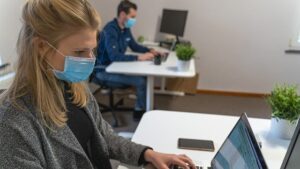return to work
Are you ready for the workplace return? Top tips on how to support your employees
The last year has meant that remote working has become the new norm for thousands of employees across the country. While this was important to stop the spread of COVID-19, it has also meant that many people have got used to their new working habits and aren’t ready to ditch the comfy clothes, get back to the early starts and return to the workplace. In this article, Alaana Woods, Commercial Director at Bupa Health Clinics, provides some guidance as your employees return to work.
 “Recent research found that 65% of employees were suffering with return-to-work anxiety and, with many organisations eager to encourage employees back into the workplace, it’s important that steps are put in place to curb anxiety and support employees to feel comfortable going back to the workplace.
“Recent research found that 65% of employees were suffering with return-to-work anxiety and, with many organisations eager to encourage employees back into the workplace, it’s important that steps are put in place to curb anxiety and support employees to feel comfortable going back to the workplace.
“As well as helping to reduce back to work anxiety, it’s also a really exciting time for employees to get back into the workplace, return to face-to-face interaction and collaboration and socialise with colleagues again.”
Be flexible
“If you didn’t have flexible working policies in place before the start of the pandemic, it’s important that these are considered for returning to the workplace. Our research found over a third of people want more flexibility in their working arrangements and it’s important that this is something businesses consider making sure employees feel supported.
“Flexible working policies can be as simple as allowing employees to manage their own time and travel in later or finish earlier to miss the rush hour commute.
“A return to the workplace will be a real transition for many people. Without the daily commute, face-to-face meetings and spending more time at home, many are going to feel the effects of getting back to fast-paced working life. Make sure they’re slowly easing back into the routine.”
Educate yourself and your team
 “Being well prepared is key to making employees feel more at ease.
“Being well prepared is key to making employees feel more at ease.
“Your internal communications are really important, so engage with your communications teams early to make sure employees know what’s expected of them when in the workplace.
“If there is training in place, make sure all your teams know how to access this and have completed it before returning to the workplace. Make sure they understand any new rules which may be in place in the workplace. For example, is there a one-way system around the workplace, can they use the kitchen area and when and where do they need to wear facemasks?”
Listen
“Make sure you’re aware of how your employees are feeling; some may be excited about being back in the workplace, while others may feel anxious or hesitant about it. As a manager it’s important to manage these feelings and signpost to any support that may be available. Manager training on how to support employees back into the workplace may also be available.”
Make sure wellbeing services are in place
“The pandemic has put healthcare at the front of everyone’s minds, so ensuring your employees have access to the services they need is important in making sure they’re supported. This can range from mental wellbeing services, Employee Assistance Programmes (EAPs), GP appointments or health assessments to keep people well and support any physical or mental health need they may have.
“Overall, getting back to the workplace should be an exciting time for employees and organisations. Making sure the right support is available and easing people slowly back into routines, is essential to help get the City up and running again.”
Are you ready for the workplace return? Top tips on how to support your employees
"It’s important that steps are put in place to curb anxiety and support employees to feel comfortable going back to the workplace."
Safety & Health Practitioner
SHP - Health and Safety News, Legislation, PPE, CPD and Resources Related Topics
Lives depend on asbestos action, says IOSH
Rule-6 tames complexity
Who helps the helpers?

 “Recent research found that 65% of employees were suffering with
“Recent research found that 65% of employees were suffering with  “Being well prepared is key to making employees feel more at ease.
“Being well prepared is key to making employees feel more at ease.
What about the pre-coronavirus predictable occupational health risks 58% of DSE operators experience in “carrying-on regardless of self-harming highlighted in the HSE Better Display Screen RR 561 2007 ?
Maybe much later but, regulatory solution have been in place since 2018/19 WCAG 2.1 Colour Contrast Validation for websites and ISO 30071.1 DSE Colour Contrast Calibration to mitigate early onset vision stress or Screen Fatigue and CVS resulting in myopic and asthenopic disease from over-exposure to sub-optimally calibrated content & DSE.